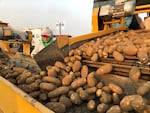
Columbia Basin potatoes move on a belt during harvest in 2021.
Anna King / NWPB
For two years, Northwest farmers didn’t have enough potatoes for processors.
The crops yielded under what was expected. Processors were buying potatoes from the Midwest, East Coast and even Canada to make fries. Fast food restaurants weren’t getting all the fries that they could sell.
But then, last year processors hedged and planted more. Baw-wang! Good amounts of spuds were dug out of the ground. Now, those spuds are getting older in storages, and the new crop is just about to be dug. There’s still too many potatoes.
Dale Lathim is the executive director of the Potato Growers of Washington, which represents Washington and Oregon growers.
“A year ago we had the shortest supply situation in history, and this year we have the longest supply situation in history,” Lathim said. “So in one short year we’ve gone from one extreme to the other.”
Related: A glut of french fries potatoes means a big spud dump across Northwest
So in order to manage that situation, processors paid for the extra potatoes — but they have growers dispose of them for other uses, like cattle feed and for food banks.
“Some of them have been dumped out in fields and canyons and anywhere else where we can just get rid of them,” Lathim said. “Here we don’t have a hard enough winter to do much of that, so that was very limited on what was happening here. But in Idaho and Alberta, where they have a much harder winter, most of those potatoes did end up going into fallow fields, where they won’t be a problem for diseases and pests.”
Adam Weber grows a couple thousand acres toward Quincy, Washington — potatoes, sweet corn, apples, cherries and irrigated red winter wheat.
“We cut (our potatoes) back 10%, but everyone across all commodities were down,” he said. “Could have been worse. There’s many guys that cut more than that.”
Related: Oregon State University tackles organic potato spoilage challenge with $2M federal grant
Weber said it isn’t fun to grow less potatoes, and make less money.
“It makes you tighten your belt a bit more, and watch every dollar that goes out,” he said.

FILE - A worker in the Columbia Basin helps sort Northwest potatoes at harvest in 2018.
Anna King / NWPB
Oh, fluffy
If you consider fresh, golden, fluffy-inside fries to be your kind of produce, it’s almost your peak season! The best time to eat fries is from about August to mid-October. That’s when farmers start digging potatoes in the Mid-Columbia and the fry processors fill the pipeline with the new crop.
Related: How 2 Oregon brothers’ efforts to mitigate food waste created the beloved tater tot
Lathim said this year is expected to be a fair crop according to the U.S. Department of Agriculture estimates, so there will be plenty of Northwest fries.
According to the U.S. Department of Agriculture National Agricultural Statistics Service, farmers across Washington, Oregon and Idaho are estimated to dig about 30,000 acres starting next week in July and about 516,000 total acres this year.